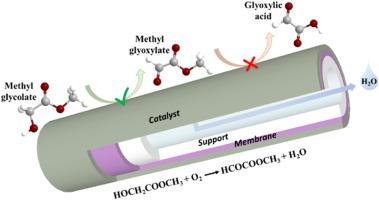催化膜反应器原位水分离增强甘醇酸甲酯氧化为乙醛酸甲酯的能力
IF 8.4
1区 工程技术
Q1 ENGINEERING, CHEMICAL
引用次数: 0
摘要
氧对羟乙酸甲酯的选择性氧化是合成乙醛酸甲酯的一条绿色途径,但它面临着乙醛酸甲酯与副产物水发生连续水解反应等巨大挑战。在此,我们制作了一种原位水分离催化膜反应器(CMR)来抑制乙醛酸甲酯的水解反应,它能通过亲水性 NaA 膜及时、优先地将水从反应体系中去除。在 260 °C 和 2 bar 条件下,MoO3@NaA CMR 的乙醛酸甲酯选择性高达 84.0%,比传统的固定床反应器(FBR)高出 32.4%,而两种模式的乙醇酸甲酯转化率几乎相同。此外,CMR 中水导致的 MoO3 催化剂失活也受到了极大的抑制,与 FBR 相比表现出了极佳的稳定性。这项工作中的原位水分离策略为提高易水解产物的选择性提供了一个新概念。本文章由计算机程序翻译,如有差异,请以英文原文为准。

In-situ water separation enhanced methyl glycolate oxidation to methyl glyoxylate by catalytic membrane reactor
The selective oxidation of methyl glycolate by oxygen is a green route for the synthesis of methyl glyoxylate, which however faces great challenges like the consecutive hydrolysis reaction between methyl glyoxylate and by-product water. Herein, we fabricated an in-situ water separation catalytic membrane reactor (CMR) to suppress the hydrolysis of methyl glyoxylate, which can promptly and preferentially remove water from the reaction system by a hydrophilic NaA membrane. The MoO3@NaA CMR achieved a high methyl glyoxylate selectivity of 84.0 % at 260 °C and 2 bar, being 32.4 % higher than that of the conventional fixed-bed reactor (FBR), while the methyl glycolate conversion was almost the same for both modes. Moreover, the deactivation of the MoO3 catalyst caused by water in CMR was also greatly inhibited, exhibiting excellent stability as compared to FBR. The in-situ water separation strategy in this work contributed to a new concept to improve the selectivity of easily hydrolyzable products.
求助全文
通过发布文献求助,成功后即可免费获取论文全文。
去求助
来源期刊

Journal of Membrane Science
工程技术-高分子科学
CiteScore
17.10
自引率
17.90%
发文量
1031
审稿时长
2.5 months
期刊介绍:
The Journal of Membrane Science is a publication that focuses on membrane systems and is aimed at academic and industrial chemists, chemical engineers, materials scientists, and membranologists. It publishes original research and reviews on various aspects of membrane transport, membrane formation/structure, fouling, module/process design, and processes/applications. The journal primarily focuses on the structure, function, and performance of non-biological membranes but also includes papers that relate to biological membranes. The Journal of Membrane Science publishes Full Text Papers, State-of-the-Art Reviews, Letters to the Editor, and Perspectives.
 求助内容:
求助内容: 应助结果提醒方式:
应助结果提醒方式:


